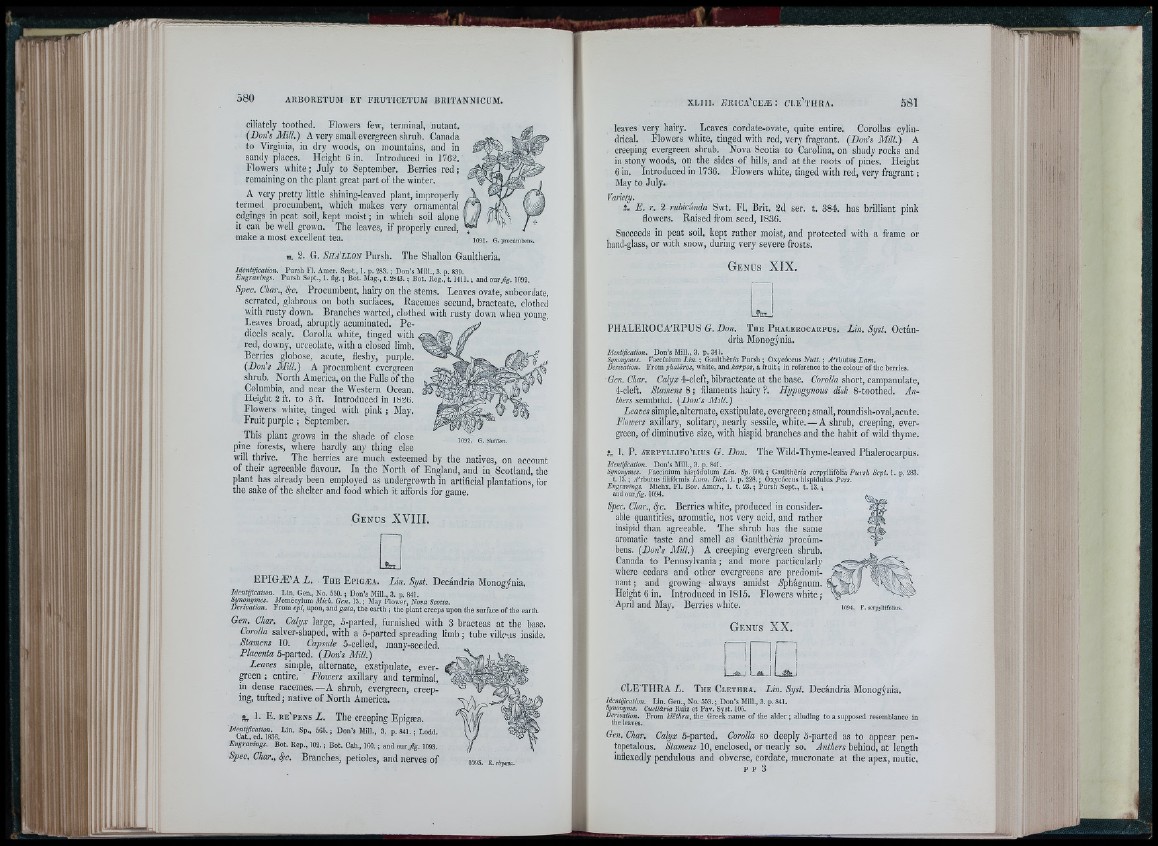
i l !
j
ciliately toothed. Flowers few, terminal, nutant.
(Doris Mi/l.) A very small evergreen shrub. Canada
to Virginia, in dry woods, on mountains, and in
sandy places. Height 6 in. Introduced in 1762.
Flowers white; July to September. Berries red;
remaining on the plant great part of the winter.
A very pretty little shining-leaved plant, improperly
termed procumbent, which makes very ornamental
edgings in peat soil, kept moist; in which soil alone
it can be well grown. The leaves, if properly cured,
make a most excellent tea. lo g j. g . procúmben,.
*1, 2. G. S h a 'l l o n Pursh. The Shallon Gaultheria.
Identification. Pursh Fl. Amer. Sept., 1. p. 28.S. ; Don’s Mill., 3. p. 839.
Engravings. Pursh Sept., 1. fig.; Bot. Mag., t. 2843. ; Bot. Reg., t. 1411.; and o u r /g . 1092.
Spec. Char., 4c. Procumbent, hairy on the stems. Leaves ovate, subcordate,
serrated, glabrous on both surfaces. Racemes secund, bracteate, clothed
with rusty down. Branches warted, clothed with rusty down when young.
Leaves broad, abruptly acuminated. Pe dicels
scaly. Corolla white, tinged with .
red, downy, urceolate, with a closed limb.
Berries globose, acute, fleshy, purple.
{Don’s Mill.) A procumbent evergreen
shrub. North America, on the Falls of the
Columbia, and near the Western Ocean.
Height 2 ft. to 3 ft. Introduced in 1826.
Flowers white, tinged with pink ; May.
Frnit purple ; September.
^ This plant grows in the shade of close
pine forests, where hardly any thing else
will thrive. The berries are much esteemed bv the natives, on account
of their agreeable flavour. In the North of England, and in Scotland, the
plant has already been employed as undergrowth in artificial plantations, for
the sake of the shelter and food which it affords for game.
G e n u s XV III.
1092. G. SháUon.
EPIGzE'A L. T h e E p i GjEA. Lin, Syst. Decándria Monogynia,
Identification. Lin. Gen., No. 550. ; Don’s Mill., 3. p 841.
Synonymes. A/emécylum Mich. Gen. 13.; May Flower, Nova Scotia.
Derivation. From epi, upon, and gaia, the earth ; the plant creeps upon the surface of the earth.
Gen. Char. Calyx large, 5-parted, furnished with 3 bracteas at the base.
Corolla salver-shaped, with a 5-parted spreading limb; tube villous inside.
Stamens 10. Capsule 5-celled, many-seeded.
Placenta 5-parted. {Doris Mill.)
Leaves simple, alternate, exstipulate, evergreen
; entire« Flowers axillary and terminal,
in dense racemes.—A shrub, evergreen, creeping,
tufted; native of North America.
i;, 1. E. r e ' p e n s L. The creeping Epigasa.
Engravings. Bot. Rep., 102.; Bot. Cab., ICO. ; and o u rfig . 1093.
Spec. Char., 4c. Branches, petioles, and nerves of
leaves very hairy. Leaves cordate-ovate, quite entire. Corollas cylindrical.
Flowers white, tinged with red, very fragrant. {Don’s Mill.) A
creeping evergreen shrub. Nova Scotia to Carolina, on shady rocks and
in stony woods, on the sides of hills, and at the roots of pines. Height
6 in. Introduced in 1736. Flowers white, tinged with red, very fragrant ;
May to July.
Variety.
^ E. r. 2 rubicûnda Swt. Fl. Brit. 2d ser. t. 384. has brilliant pink
flowers. Raised from seed, 1836.
Succeeds in peat soil, kept rather moist, and protected with a frame or
hand-glass, or with snow, during very severe frosts.
G e n u s X IX ,
PHALEROCA'RPUS G.-Dow. T h e P h a l e r o c a u p u s . Lin. Syst. Octandria
Monogynia.
Identification. Don’s Mill., 3. p. 341.
Synonymes. Faccinium Lin. ; Gaulthèn'a Pursh ; Oxycóccus Nutt. ; «4'rbutus Lam.
Derivation. From phalëros, white, and karpos, a fruit ; in reference to the coiour of the berries.
Gen. Char. Calyx 4-cleft, bibracteate at the base. Corolla short, campanulate,
4-cIeft. Stamens 8 ; filaments hairy ?. Hypogynous disk 8-toothed. Anthers
semibifid. {Don’s Mill.)
Leaves simple,alternate, exstipulate, evergreen; small, roundish-oval,acute.
Flowers axillary, solitary, nearly sessile, white. — A shrub, creefnng, evergreen,
of diminutive size, with hispid branches and the habit of wild thyme.
I, 1. P. 5 E r p y l l i f o 'l i u s G. Don. The Wild-Thyme-leaved Phalerocarpus.
Identification. Don’s Mill., 3. p. 841
Synonymes. Faccinium hispldulum _
t. 13. ; /i'rbutus filifórmis Lam. Dict. 1. p.*228. ; Oxycóccus hispidulus Pers.
Engravings. Michx. Fl. Bor. Amer., 1. t. 23. ; Pursh Sept., t. 13. ;
and ourfig. 1094.
Spec. Char., 4c. Berries white, produced in considerable
Lin. Sp. 500. 1 Gaulthèrm sorpyllifblia ParsA Sept. 1. p. 283.
quantities, aromatic, not very acid, and rather
insipid than agreeable. The shrub has the same
aromatic taste and smell as GaulthèrZ« procum-
bens. (Don’s Mill.) A creeping evergreen shrub.
Canada to Pennsylvania ; and more particularly
where cedars and other evergreens are predominant
; and growing always amidst iS'phagnum.
Height 6 in. Introduced in 1815. Flowerswhite;
April and May. Berries white.
G e n u s X X .
luluf fr'
j1
!
èiggkê i
1094. F. jerpyllifòlius.
C’LE'THRA L, T h e C l e t h r a . Lin. Syst. Decándria Monogynia.
Identification. Lin. Gen., No. 553. ; Don’s Mill., 3. p. 841.
Synonyme. CucUàric. Ruiz et Pav. Syst. 105.
Derivation. From klethra, the Greek name of the alder ; alluding to a supposed resemblance in
the leaves.
Gen. Char. Calyx 5-parted. Corolla so deeply 5-parted as to appear pen-
tapetalous. Stamens 10, enclosed, or nearly so. Anthers behind, at length
inftexedly pendulous and obverse, cordate, mucronate at the apex, mutic.
p p 3
'M
li,